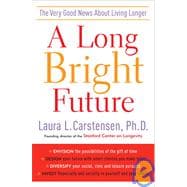
LAURA L. CARSTENSEN, Ph.D., is one of the world's leading authorities on longevity and aging. A professor of psychology at Stanford University and founding director of the Stanford Center on Longevity, she has won numerous awards, including a Guggenheim Fellowship. Her research has been supported for more than twenty years by the National Institute on Aging. Dr. Carstensen lives in Los Altos Hills, California.
| Acknowledgments | p. ix |
| Introduction | p. 1 |
| Five Myths About Aging You Can't Afford to Believe | p. 13 |
| What is Aging? | p. 43 |
| Reenvisioning Long Life | p. 65 |
| The Social Side of Aging | p. 97 |
| Collective Supports: Social Security and Medicare | p. 137 |
| Investing in Our Future: The Case for Science and Technology | p. 175 |
| What Might Go Wrong? | p. 219 |
| Ensuring a Long Bright Future | p. 253 |
| Endnotes | p. 285 |
| Index | p. 307 |
| Table of Contents provided by Ingram. All Rights Reserved. |
The New copy of this book will include any supplemental materials advertised. Please check the title of the book to determine if it should include any access cards, study guides, lab manuals, CDs, etc.
The Used, Rental and eBook copies of this book are not guaranteed to include any supplemental materials. Typically, only the book itself is included. This is true even if the title states it includes any access cards, study guides, lab manuals, CDs, etc.
Excerpted from A Long Bright Future: An Action Plan for a Lifetime of Happiness, Health, and Financial Security by Laura L. Carstensen
All rights reserved by the original copyright owners. Excerpts are provided for display purposes only and may not be reproduced, reprinted or distributed without the written permission of the publisher.